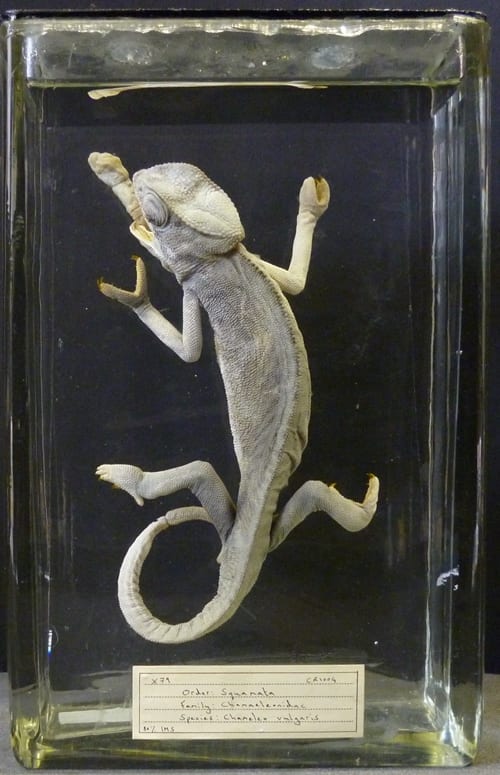Specimen of the Week 225: The preserved Chameleon
By ycrnsmk, on 1 February 2016
“Karma Karma Karma Karma Karma Chameleon”
The English band, Culture Club said almost everything one needs to know about this week’s Specimen of the Week with their 1983 hit single “Karma Chameleon”.
Using the wise words of the Culture Club to guide us, we will embark on a journey of discovery and come to find that this reptile group, containing approximately 180 different types is anything but common. That said, this week’ Specimen of the Week is……….
**The preserved Common Chameleon (Chamaeleo chamaeleon)**
1. Desert loving all the way
Chameleon species are found primarily in mainland sub-Saharan Africa and on the island of Madagascar this part of the song does in fact ring true, but is by no means the whole story. Chameleons also inhabit rainforests, savannas and steppes in northern Africa, Southern Europe, the Middle East and islands of the Western Indian Ocean. They are arboreal creatures that spend their days residing in trees and bushes.
2. Didn’t hear your wicked words every day
Although chameleons can’t exactly talk they do use their tongues at ballistc speeds to capture their prey. Their tongues are almost one and half to two times the length of their bodies, which they project outwards through an elastic recoil mechanism. They are primarily insectivorous but will eat leaves when other sources of water are unavailable.
3.That my love was an addiction
Far from the truth…chamaleons prefer to live alone. Males and females only tend to tolerate each other briefly during the mating season.. Chameleons are mostly oviparous meaning they lay eggs. Upon copulation it takes three to six weeks for chameleons to lay eggs, which females deposit in a hole they have dug. Depending on the species the eggs will hatch between four to twelve months later. Male chameleons bob their heads and inflate their throats to puff up their bodies to attract females. Exhibiting their brighest colours…I guess loving would really be easy if your colours were like my dreams.
4. Red, gold, and green, red, gold, and green
Chameleons are most famous for their ability to change the colour of their skin. Most people believe that this function is an adapation for survival, allowing chameleons to disappear within their surroundings. This is however untrue, as it primarily functions as a social signal. They are able to communicate their mood and aggression while displaying territorial and mating behaviour. They are able to do so, due to overlapping layers within their skin, responsible for controlling color and thermoregulation. The top layer of their skin contains guanine nanocrystals, which they can manipulate the structure of, when excited. The change in space between the layer of cells affects which wavelengths of light are reflected and which are absorbed. When excited the distance between the cells will increase allowing for a longer wavelength of light to be reflected. These changes are responsible for the variation in a chamaleons skin color, which can represent itself as combinations of yellow, red, orange when excited and as a blend of green, blue, black when relaxed. Unfortunately these colours do not survive the preservation process.

Common chameleon (probably not actually singing). Image by Steffen Temp; CC-BY-SA-3.0 via Wikimedia Commons.
5. Ev’ry day is like survival
Evidence of chameleon fossils date back 80 million years. Although, they have roamed this planet for so many years, a large number of species are threatened by extinction. On a global scale about 36% of chameleons are endangered, not taking into account those that have not yet been assessed by the IUCN. Their struggle for survival is largely due to human factors, although climate change is understood to be responsbile as well. They are threatened by loss of habitat due to agriculture and the exploitation of biological resources. Deforestation plays a large role in the species depletion. In addition, the international illegal collection of chameleons for pet trade has also greatly affected the numbers of certain species. 85 species of chameleons can be found in Madagascar, which is suffering large scale forest loss due to slash-and-burn farming. Thankfully, conservation projects have been put in place within Madgascar as a way of developing a sustainable environment for chameleons. Hopefully, we will see an increase in their numbers in the next few years.
But until then….
“Karma Karma Karma Karma Karma Chameleon”
References:
- Administrator (2015) Trade and conservation of Madagascar’s chameleons. Available at: http://www.madagasikara-voakajy.org/index.php?option=com_content&view=article&id=34:chameleons&catid=39:projects&Itemid=61 (Accessed: 29 January 2016).
- Dever, Jennifer (December 5, 2007). “Common Chameleon” Common Chameleon. usfca.edu. Retrieved January 29, 2016.
- Hance, J. (2014) Chameleon crisis: Extinction threatens 36% of world’s chameleons. Available at: http://news.mongabay.com/2014/11/chameleon-crisis-extinction-threatens-36-of-worlds-chameleons/ (Accessed: 29 January 2016).
- Teyssier, Jeremie; Saenko, Suzanne V.; Milinkovitch Dirk can der Marel & Michel C. (2015). “Photonic crystals cause active colour change in chameleons.” nature Communications (6). http://www.nature.com/ncomms/2015/150302/ncomms7368/full/ncomms7368.html
Sophie Kostelecky is a Visitor Services Volunteer at the Grant Museum of Zoology, and a UCL Archaeology and Anthropology student.
 Close
Close



